กำลังเชิงดัดของการเสริมกำลังคานคอนกรีตเสริมเหล็กรับแรงดึง ด้วยแผ่นพอลิเมอร์เสริมเส้นใยคาร์บอนยึดติดจากภายนอก
บทคัดย่อ
ปรากฏการณ์ที่ไม่พึงปรารถนาของการวิบัติจากการหลุดล่อนโดยเริ่มต้นที่บริเวณปลายของแผ่น FRP เป็นสาเหตุทำให้แผ่น FRP ลอกออกก่อนที่น้ำหนักบรรทุกออกแบบจะเข้าสู่ค่าที่เหมาะสมดังที่ได้คาดการณ์ไว้ ในการศึกษาเชิงทดลองนี้คำนึงถึงการตอบสนองเชิงดัดและความสามารถด้านกำลังของคานคอนกรีตเสริมเหล็กรับแรงดึงอย่างเดียวที่เสริมกำลังโดยการยึดติดแผ่นพอลิเมอร์เสริมเส้นใยคาร์บอน (CFRP) ภายนอกคานด้วยอีพ็อกซี่ร่วมกับการจัดเตรียมการรัดที่ปลายของแผ่นทั้ง 4 ด้านของหน้าตัดคาน วัตถุประสงค์ของการศึกษานี้มี 2 ประการ ประการแรกคือเพื่อศึกษาความสามารถในการแบกรับน้ำหนักบรรทุกและพฤติกรรมการแอ่นตัวของคานและประการที่สองคือเพื่อทดสอบผลกระทบของตำแหน่งน้ำหนักบรรทุกกระทำและกำลังของคอนกรีตที่มีผลต่อคานเสริมกำลัง ผลลัพธ์จากการทดสอบนำเสนอในรูปแบบของกราฟในพจน์ของความสัมพันธ์ระหว่างแรงกระทำและการแอ่นตัว น้ำหนักบรรทุกแตกร้าวแรกและน้ำหนักบรรทุกประลัยสำหรับคานคอนกรีตเสริมเหล็กหาได้จากทั้งการทดลองและการคำนวณเชิงทฤษฎี นอกจากนี้ น้ำหนักบรรทุกครากและน้ำหนักบรรทุกจากการหลุดล่อนสามารถสังเกตและหาได้รับจากความสัมพันธ์ระหว่างน้ำหนักบรรทุกและการแอ่นตัวสำหรับคานควบคุมและคานเสริมกำลังตามลำดับ
เอกสารอ้างอิง
Park R, Paulay T. Reinforced Concrete Structures. New York: John Wiley & Sons Inc.; 1975.
Nilson AH, Winter G. Design of Concrete Structures. 11th ed. Singapore: McGraw-Hill Inc.; 1991.
Nawy EG. Reinforced Concrete: A funda-mental Approach. 4th ed. New Jersey: Prentice Hall Inc.; 2000.
Hollaway LC, Leeming MB. Strengthening of Reinforced Concrete Structures: Using Externally-Bonded FRP Composites in Structural and Civil Engineering. Cam-bridge: Woodhead Publishing; 2001.
GangaRao HVS, Taly N, Vijay PV. Rein-forced Concrete Design with FRP Com-posites. Boca Raton: Taylor & Francis Group LLC.; 2007.
Balaguru P, Nanni A, Giancaspro J. FRP Composites for Reinforced and Pre-stressed Concrete Structures: A Guide to Fundamentals and Design for Repair and Retrofit. New York: Taylor & Francis Group LLC.; 2009.
Rasheed HA. Strengthening Design of Reinforced Concrete with FRP. Boca Raton: Taylor & Francis Group LLC.; 2015.
Wu H-C, Eamon CD. Strengthening of Concrete Structures Using Fiber Rein-forced Polymers (FRP): Design, Con-struction and Practical Applications. Cambridge: Woodhead Publishing; 2017.
ACI 440.2R-17. Guide for the Design and Construction of Externally Bonded FRP Systems for Strengthening Concrete Structures. Michigan: American Concrete Institute (ACI) Committee 440; 2017.
Chajes MJ, Thomson TA, Januszka TF, Finch WW. Flexural strengthening of con-crete beams using externally bonded composite materials. Constr Build Mater. 1994; 8: 191-201.
Varastehpour H, Hamelin P. Strengthen-ing of concrete beams using fiber-reinforced plastics. Mater Struct. 1997; 30: 160-6.
Ramana VPV, Kant T, Morton SE, Dutta PK, Mukherjee A, Desai YM. Behavior of CFRPC strengthened reinforced concrete beams with varying degrees of streng-thening. Compos B Eng. 2000; 31: 461-70.
Azevedo DMM, Juvandes LFP, Henriques AAR. Flexural strengthening with FRP sys-tems experimental results vs. expected results based on actual design guide-lines. Composites in Construction 2005-Third International Conference, 2005 July 11-13, Lyon, France, 2005.
Rosenboom O, Rizkalla SH. Experimental study of intermediate crack debonding in fiber-reinforced polymer strengthened beams. ACI Struct J. 2008; 105: 41-50.
Perera R, Bueso-Inchausti D. A unified approach for the static and dynamic analyses of intermediate debonding in FRP-strengthened reinforced concrete beams. Compos Struct. 2010; 92: 2728-37.
Hamed E, Bradford MA. Flexural time-dependent cracking and post-cracking behaviour of FRP strengthened concrete beams. Int J Solids Struct. 2012; 49: 1595-607.
Bykov AA, Kalugin AV. New model for evaluation of FRP debonding strain for Russian design code. Adv Mater Sci Eng. 2013; 2013: 130162.
Ding J, Wang F, Huang X, Chen S. The effect of CFRP length on the failure mode of strengthened concrete beams. Polymers. 2014; 6: 1705-26.
Bennegadi ML, Hadjazi K, Sereir Z, Amziane S, El Mahi B. General cohesive zone model for prediction of interfacial stresses induced by intermediate flexu-ral crack of FRP-plated RC beams. Eng Struct. 2016; 126: 147-57.
Mostafa AAB, Razaqpur AG. Finite element model for predicting post delamination behaviour in FRP-retro-fitted beams in flexure. Constr Build Mater. 2017; 131: 195-204.
Nguyen-Minh L, Phan-Vu P, Tran-Thranh D, Truong QPT, Pham TM, Ngo-Huu C, Rovnak M. Flexural-strengthening effi-ciency of cfrp sheets for unbonded post-tensioned concrete T-beams. Eng Struct. 2018; 166: 1-15.
Chen C, Wang X, Sui L, Xing F, Chen X, Zhou Y. Influence of FRP thickness and confining effect on flexural performance of HB-strengthened RC beams. Com-pos B Eng. 2019; 161: 55-67.
Zhou C, Guo Y, Wang Y, He X, Xiong Z. Flexural behavior of narrow RC beams strengthened with hybrid anchored CFRP sheets. J Adv Concr Technol. 2020; 18: 54-66.
Al-Negheimish AI, El-Sayed AK, Al-Saawani MA, Alhozaimy AM. Effect of stirrups on plate end debonding in reinforced concrete beams streng-thened with fiber reinforced polymers. Polymers. 2021; 13: polym 13193322.
Zhou B, Wu R-Y, Yin S. Stress field approach for prediction of end concrete cover separation in RC beams strength-ened with FRP reinforcement. Polymers. 2022; 14: polym14050988.
ดาวน์โหลด
เผยแพร่แล้ว
รูปแบบการอ้างอิง
ฉบับ
ประเภทบทความ
สัญญาอนุญาต
ลิขสิทธิ์ (c) 2022 วารสารวิจัย มทร. กรุงเทพ

อนุญาตภายใต้เงื่อนไข Creative Commons Attribution-NonCommercial-NoDerivatives 4.0 International License.
กองบรรณาธิการวารสารวิชาการ มหาวิทยาลัยเทคโนโลยีราชมงคลกรุงเทพ มีความยินดีที่จะรับบทความจากอาจารย์ นักวิจัย นักวิชาการทั้งภายในและภายนอกมหาวิทยาลัย ในสาขาวิชาวิทยาศาสตร์และเทคโนโลยี ได้แก่ สาขาวิชาวิทยาศาสตร์ วิศวกรรมศาสตร์ และสาขาอื่นๆ ที่เกี่ยวข้อง รวมถึงสาขาต่างๆ ที่มีการบูรณาการข้ามศาสตร์ที่เกี่ยวข้องวิทยาศาสตร์และเทคโนโลยี ที่เขียนเป็นภาษาไทยหรือภาษาอังกฤษ ซึ่งผลงานวิชาการที่ส่งมาขอตีพิมพ์ต้องไม่เคยเผยแพร่ในสิ่งพิมพ์อื่นใดมาก่อน และต้องไม่อยู่ในระหว่างการพิจารณาของวารสารอื่น
การละเมิดลิขสิทธิ์ถือเป็นความรับผิดชอบของผู้ส่งบทความโดยตรง บทความที่ได้รับการตีพิมพ์ต้องผ่านการพิจารณากลั่นกรองคุณภาพจากผู้ทรงคุณวุฒิและได้รับความเห็นชอบจากกองบรรณาธิการ
ข้อความที่ปรากฏอยู่ในแต่ละบทความที่ตีพิมพ์ในวารสารวิชาการเล่มนี้ เป็นความคิดเห็นส่วนตัวของผู้เขียนแต่ละท่าน ไม่เกี่ยวข้องกับมหาวิทยาลัยเทคโนโลยีราชมงคลกรุงเทพแต่อย่างใด ความรับผิดชอบด้านเนื้อหาและการตรวจร่างบทความแต่ละบทความเป็นของผู้เขียนแต่ละท่าน หากมีความผิดพลาดใดๆ ผู้เขียนแต่ละท่านจะต้องรับผิดชอบบทความของตนเองแต่ผู้เดียว
กองบรรณาธิการขอสงวนสิทธิ์มิให้นำเนื้อหา หรือข้อคิดเห็นใดๆ ของบทความในวารสารวิชาการ มหาวิทยาลัยเทคโนโลยีราชมงคลกรุงเทพ ไปเผยแพร่ก่อนได้รับอนุญาตจากกองบรรณาธิการ อย่างเป็นลายลักษณ์อักษร ผลงานที่ได้รับการตีพิมพ์ถือเป็นลิขสิทธิ์ของวารสาร






